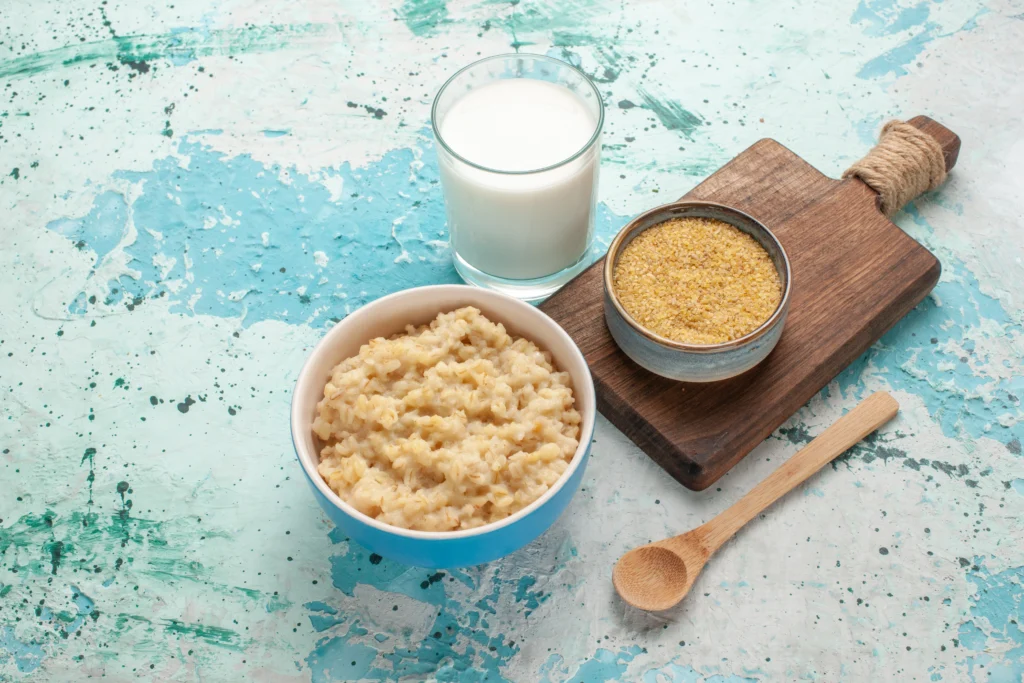Grits Nutrition Facts: Calories, Protein, and More
A Warm Bowl of Comfort – And a Surprisingly Nutritious One
You probably think of grits as a cozy Southern breakfast — creamy, buttery, and nostalgic. Maybe you’ve had them on a Sunday morning with eggs and bacon, or perhaps served up shrimp-and-grits style at a family gathering. But what you might not realize is that beneath their homey vibe lies a nutritional profile worth a closer look.
Grits are more than a starchy side dish. They’re low in fat, naturally gluten-free, and can even contribute to your protein goals with the right tweaks. If you’ve ever wondered about grits nutrition facts, you’re about to get answers — and a new appreciation for this versatile food.
Table of Contents
What Are Grits, Exactly?
Grits are ground corn, typically boiled into a porridge-like dish. While they’re a staple in Southern American cuisine, they’ve gained popularity across the country thanks to their neutral flavor and versatility.
Types of Grits You Might Encounter
- Stone-ground grits: These are the most natural form — minimally processed and full of flavor and texture. They take longer to cook but retain more nutrients.
- Quick-cooking grits: Milled more finely and partially cooked to save you time. These are common in most supermarkets.
- Instant grits: Fully precooked and dehydrated. All you need is boiling water or a microwave.
- Hominy grits: Made from corn that has been treated with lime to remove the hull, giving them a softer texture and a slightly different nutritional profile.
Each type offers something unique, but they all stem from one simple ingredient: corn.
Grits Nutrition Facts (Per Serving)
If you’re watching your intake or trying to eat more mindfully, knowing what’s in your bowl matters. Here’s a general nutritional snapshot of plain, cooked grits (1 cup serving):
Nutritional Breakdown
| Nutrient | Amount | % Daily Value (DV) |
|---|---|---|
| Calories | ~150 | 7% |
| Protein | ~3–4g | 6% |
| Carbohydrates | ~30–35g | 12% |
| Fiber | ~1g | 4% |
| Fat | ~1g | 1% |
| Iron | ~0.4mg | 2% |
| Folate | ~12mcg | 3% |
Tip: Instant grits may contain added sodium and preservatives. Always check the label if you’re watching your salt intake.
So, if you’re aiming for a balanced diet, grits offer a simple, low-fat base you can easily build upon.
Why Grits Deserve a Place in Your Diet
You might not think of grits as a “health food,” but there are several reasons you might want to reconsider.
They’re Naturally Low in Fat
When you prepare grits without adding tons of butter or cheese, they’re surprisingly light. With just about 1g of fat per serving, they fit nicely into a low-fat diet.
They’re Gluten-Free
If you’re avoiding gluten, you’ll be glad to know that grits, by nature, are gluten-free — though it’s always smart to look for certified brands if you’re sensitive to cross-contamination.
They’re Iron-Enriched
Most commercially sold grits are enriched with iron and B vitamins, especially folate and thiamin. This makes them a good option if you’re trying to boost your intake.
Great Source of Energy
Thanks to their complex carbohydrates, grits digest more slowly than sugary cereals or white bread, providing sustained energy instead of a quick spike and crash.
Protein in Grits: How Much Is Enough?
This is where grits might surprise you — or leave you wanting more.
Let’s Talk Numbers
With about 3–4 grams of protein per cup, grits aren’t exactly a powerhouse on their own. But they’re a great canvas.
Simple Ways to Boost Protein in Grits Meals
- Add eggs: Scrambled or poached eggs pair beautifully with savory grits.
- Top with cottage cheese or shredded cheddar
- Stir in plant-based proteins: Beans, lentils, or tofu
- Use milk instead of water when cooking
High-Protein Grits Add-ins:
- Two poached eggs – 12g protein
- Turkey sausage – 9g protein
- Sautéed tofu – 10g protein
- Greek yogurt topping (¼ cup) – 6g protein
With the right combination, your grits bowl can go from basic to muscle-building.
Is Eating Grits Healthy? Here’s What You Need to Know
You’ve probably seen articles calling grits both “healthy” and “unhealthy.” Here’s how to sort it out.
What Makes Grits a Good Choice
- Low in saturated fat
- Fortified with essential vitamins
- Versatile for both sweet and savory meals
Watch Out For…
- High-calorie toppings: Cheese, butter, bacon, and cream can turn a 150-calorie meal into a 600+ one.
- Sodium in instant grits: Some brands pack in over 300mg of sodium per serving.
Healthy Grits Hacks
- Cook with unsweetened almond or oat milk instead of cream.
- Add spinach, kale, or zucchini for fiber.
- Top with nutritional yeast for a cheesy flavor without the calories.
By customizing your bowl, you can enjoy all the comfort of grits without the guilt.
Grits vs. Other Popular Breakfast Grains
It helps to see how grits stack up against other common options you might be choosing from.


Grits vs. Oatmeal
- Oatmeal has more fiber (4g vs 1g)
- Grits are lower in fat
- Both offer steady energy when topped with fruit or protein
Grits vs. Cream of Wheat
- Similar texture
- Cream of Wheat has more iron but is slightly higher in calories
Grits vs. Quinoa
- Quinoa wins on protein and fiber but has more calories
- Grits are better for volume and cost
Nutritional Comparison Table
| Food Item | Calories | Protein | Fiber | Gluten-Free |
|---|---|---|---|---|
| Grits | 150 | 3–4g | 1g | Yes |
| Oatmeal | 150 | 5g | 4g | Usually No |
| Quinoa | 220 | 8g | 5g | Yes |
| Cream of Wheat | 170 | 4g | 1g | No |
Healthy and Easy Grits Recipes
Want to enjoy grits without blowing your calorie budget? Try these recipes that balance flavor and nutrition.
Savory Breakfast Grits Bowl
| Ingredient | Amount | Calories | Protein |
|---|---|---|---|
| Stone-ground grits | 1 cup | 150 | 3g |
| Poached egg | 1 | 70 | 6g |
| Spinach (steamed) | ½ cup | 20 | 1g |
| Olive oil | 1 tsp | 40 | 0g |
| Feta cheese | 1 tbsp | 25 | 1g |
Total: ~305 calories, 11g protein
Sweet Grits with Berries and Honey
- Cook grits with almond milk and a dash of cinnamon
- Top with:
- ½ cup fresh blueberries
- 1 tsp honey
- Chia seeds (1 tbsp for fiber and omega-3s)
FAQs About Grits Nutrition Facts
Are grits good for weight loss?
Yes — when portioned and paired with lean protein or veggies, grits can keep you full without excessive calories.
Do grits spike blood sugar?
They have a moderate glycemic index. Balance them with fiber (like vegetables) and protein to reduce the spike.
Are instant grits bad for you?
Not inherently, but they can contain added salt, sugar, and preservatives. Always check the ingredient list.
Are grits safe for a gluten-free diet?
Yes, grits are naturally gluten-free. Just make sure they’re processed in a gluten-free facility if you’re highly sensitive.
Are grits keto-friendly?
Not really. Grits are high in carbohydrates — about 30g per cup. They’re not suitable for strict keto, but small portions may fit a low-carb plan.
Conclusion: Your Grits, Your Way
Now that you understand the grits nutrition facts, you’re equipped to make better choices about how and when to enjoy them. Whether you’re crafting a post-workout meal or simply craving comfort food, grits can work for you — not against you — with a little creativity.
Keep it simple, keep it wholesome, and make every bite count. And next time someone tells you grits are just empty calories? You’ll know better.
Call to Action: What’s Your Favorite Way to Enjoy Grits?
We’d love to hear how you make grits part of your day! Do you go sweet with fruit or savory with eggs and greens? Drop your favorite combo in the comments, or share this article with a friend who needs a little more comfort food in their life — the healthy kind.
Did you benefit anything?
There are no reviews yet. Be the first one to write one.

